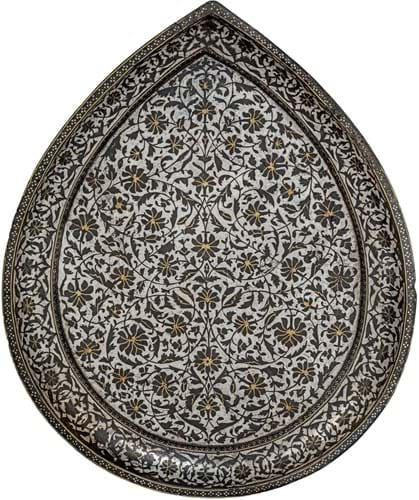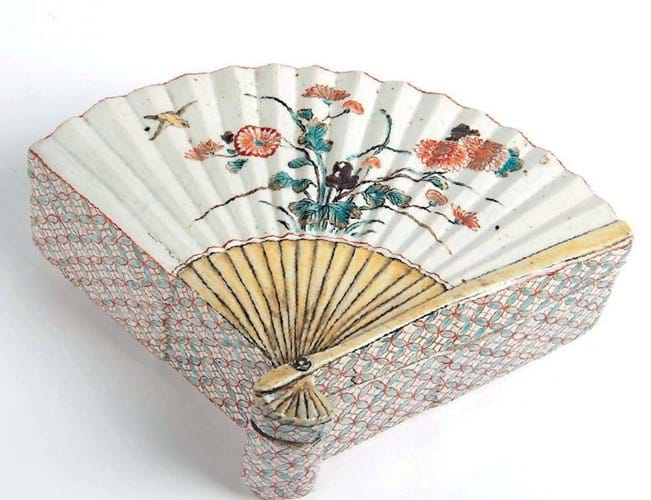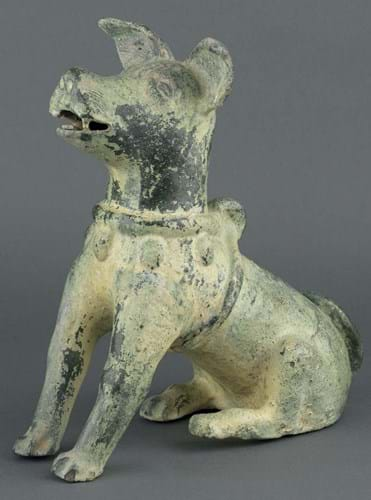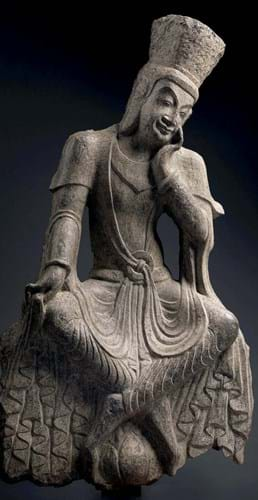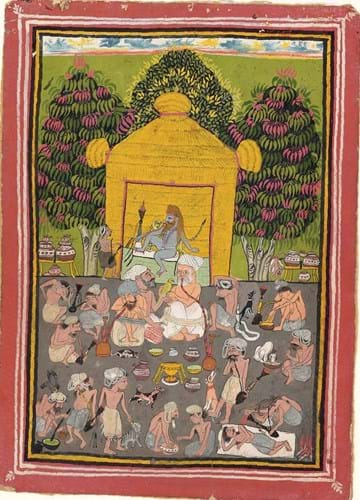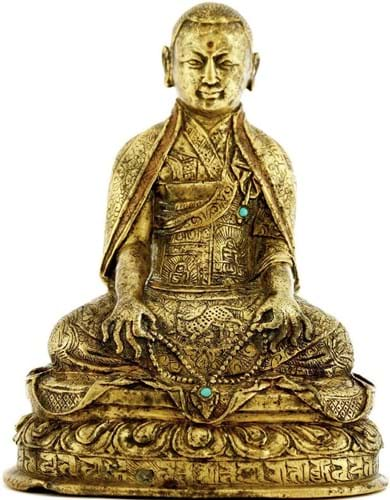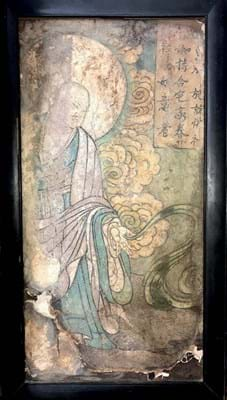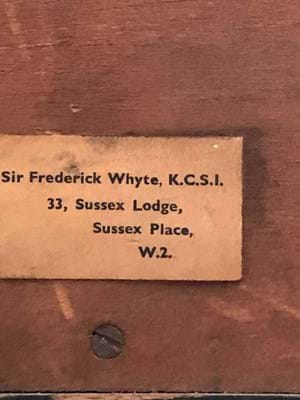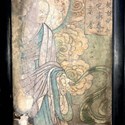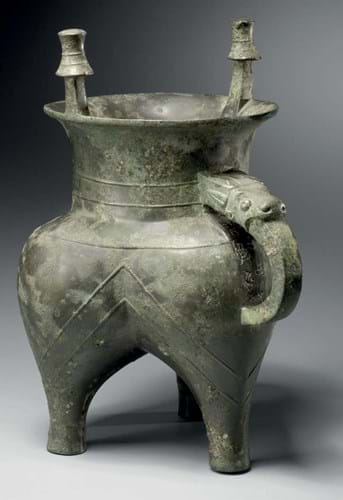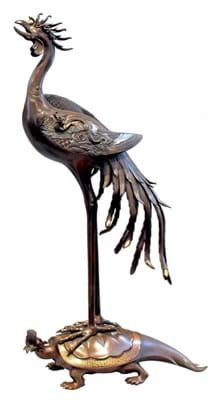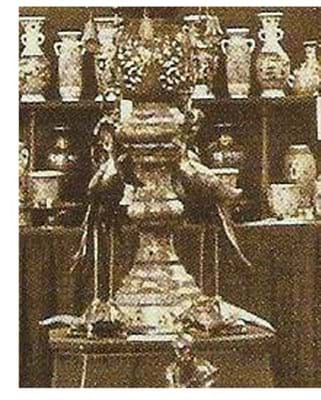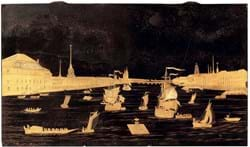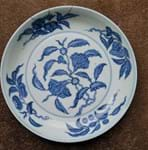Serving ‘unparalleled’ aftabi
A 17th century tear-shaped bidri tray
Simon Ray: £POA
Writing of this 14in (35cm) bidri tray in his seminal book on Indian metalwork, Gold, Silver & Bronze from Mughal India (1997), author Mark Zebrowski says: “This tear-shaped tray stands apart from other 17th century bidri pieces. Its great sweep of arabesque in the aftabi technique, its discreet inlays of brass, its broad cavetto and its fusion of powerful, simple form with extremely fine ornament is unparalleled.”
The metalworking technique, used to create black patterns of buds, blooms, leaves, coils and tendrils against a gleaming silver ground, is known as aftabi from the Persian word for sunshine or lustre. It reverses the visual effect of more typical silver-on-black bidri wares, although it was both more expensive and more difficult to execute. Brass inlays are added using the tarkashi technique (wire inlay) and tehnishan (where the inlay is applied flush to the surface). It was probably made in Bidar in Deccan.
The number of available aftabi bidri objects is very small, with this piece the only one of its type dealer Simon Ray has seen.
It was owned until recently by the London collector Bashir Mohamed who had bought it in 1974 from Anthony ‘Tobi’ Jack, the tribal art dealer who moved to London from his native Auckland in the early 1960s.
Jenyns collection breezes in
Soame Jenyns (1904-76), a renowned British art historian, collector and connoisseur, was a well-known figure in the field of east Asian art. He worked at the British Museum and wrote several definitive books on Chinese and Japanese ceramics. Now out of print, some of these works change hands for over 30 times their original cost, a sign of their enduring practical value.
Christie’s will be selling his collection in November with 24 lots included in the Fine Chinese Ceramics and Works of Art sale on November 6, alongside 138 lots in a dedicated online sale from November 1-8. The entire collection is estimated in excess of £540,000.
Edo period Japanese lacquer and porcelain features prominently, with examples of Kakiemon and Arita wares. Included in the online sale is this rare mid-17th century Kutani porcelain box made in the form of a fan. It is estimated at £20,000- 30,000. The name Kutani is now loosely applied to a great variety of 19th century Japanese ceramics, but correctly refers to porcelain made in Kaga province (now in Ishikawa Prefecture) under the patronage of the powerful Maeda family in the decades before the Genroku period (1688-1704).
Ritsuo’s vengeful female
Anchored in the Shinto belief that souls can return to the earth as ghosts, Japan has a long tradition of supernatural fables. In particular, a menagerie of demonic creatures, often invoked to explain natural disaster, misfortune or disease, has fuelled the imaginations of writers and artists.
The Sydney L Moss gallery will delve into this darker side of Japanese folklore with its exhibition devoted to bakemono (ghosts) and their evil brethren. The show, featuring lacquer work, pipe cases, inro and netsuke, runs from November 1-10.
This 6½in (16cm) lacquer kagamibako (mirror box) by the celebrated Edo period craftsman Ogawa Haritsu, better known as Ritsuo (1663-1747), is inlaid with a ceramic mask of the female demon Hannya. Once human, she becomes the vengeful ghost of a jealous woman, who has returned to haunt those who scorned her in life. Ritsuo depicts her as a noh theatre mask, with bull-like horns, a wicked smile and manic bulging eyes, escaping from its cloth wrappings.
Market guardian
Kensington Church Street dealership Marchant is devoting an October 29- November 16 exhibition to Chinese Ceramics from Han to Song. The 93-year-old gallery has always handled these wares but this will be the first catalogue in its long history dedicated to the subject.
Marchant says the show reflects the recent upturn in demand for early ceramics as collectors rediscover this field. Many of the 35 items in the exhibition, including 13 pieces from the collection of Robert Tang, a well-known collector of Song dynasty (960-1279) ceramics, come with extensive provenance.
Pictured here is a 13in (33cm) green glazed Han (206BC-220AD) pottery dog – the first of its type Marchant has sold. Hunting dogs were part of Chinese society from very early times, with many words for hunting in the Chinese language still written using the radical for dog.
As a result of their importance to the Han court, an ‘inspector of kennels’ was appointed to oversee the raising and training of hunting dogs at the Shanglin palace gardens.
This is one of only a handful of this model recorded, the hound shown in a seated position as if guarding his master’s doorway with open mouth, forward-pointing ears and a tail curled back across the body. He wears a harness with five pendant tassels and has an even green glaze with a silver iridescence due to oxidisation. Models such as this were formed using two-part moulds with sometimes whimsical details such as the incised eyebrows and whiskers added later.
Second slice of Kurland
Part two of the sale of the collection of American film and television agent Norman A Kurland will be offered by Asian art dealership Eskenazi this autumn. The collector spent four decades assembling Chinese works from the Six Dynasties period (220-581AD). Part one of the sale took place in 2017. The second exhibition comprises 38 works of early Buddhist sculptures, earthenware, metalwork and textiles.
One of the highlights is a 2ft (61cm) high carved limestone Maitreya buddha from the Northern Wei Dynasty (early 6th century). The work comes from the imperially sponsored Longmen cave temples in Henan province. The grottoes, some 2300 caves and niches carved into the rock, were designated a UNESCO World Heritage site in 2000.
This sculpture assumes the form known as the ‘pensive’ figure, a posture representing deep contemplation or serious thought that became very popular during the 5th and 6th centuries in China. It is thought they depict either Maitreya, the bodhisattva of the future, or devotees of the Maitreya cult as they experience enlightenment.
A number of similar figures are known from the Longmen complex, but only a handful assume this exact pose.
This buddha was bequeathed by Arthur B Michael to the Albright-Knox Art Gallery in Buffalo, New York, in 1942 and formed part of a travelling exhibition in 1976-77. When deaccessioned by the Albright-Knox at Sotheby’s New York in 2007, it was bought by Eskenazi and then sold to Kurland.
Su Shi’s exile in Salisbury
The Kangxi (1662-1722) mark and period wucai cup offered in the November 13 sale at Woolley & Wallis is painted with a scene from a famous poem by Su Shi (1037-1101) from the Chibi fu (‘Ode to the Red Cliff’). It depicts the poet and his friends enjoying a picnic in a boat and marvelling at the cliffs
Su Shi, a major personality of the Song era, was exiled to the provinces by a reformist faction at court, and his visit to the famous naval battle site at Chibi made him reflect on the transient quality of life and the nature of people.
The poem to the reverse reads: ‘I raised my wine cup and toasted my guests, joining them in chanting the Ode to the Bright Moon and the Song of Sylphs’. It also bears a seal which reads: ‘Elegance’. This 2in (5cm) cup has a provenance to both John Sparks and then to Sydney L Moss from where it was bought by an English private collector in 1963 for £60.
Intoxicated ascetics in Indian
Francesca Galloway, specialist in Indian miniatures and courtly objects, will be showing paintings from the Ludwig Habighorst collection, at the Frieze Masters fair held in London’s Regent’s Park on October 4-7, and later as part of Asian Art in London.
A chance encounter with Indian miniatures nearly 50 years ago inspired Habighorst’s lifelong passion for the subject.
The professor of radiology’s acquisitions were multifaceted – but of particular interest are a number of depictions of the preparation and consumption of bhang, a form of edible cannabis, used in food and drink from as early as 1000BC in the region of south Asia.
Gods and mortals are shown to be equally involved in this pursuit: one beautifully rendered scene shows the holy family revelling together in a mountainous landscape. Shiva and his wife Parvati are sieving the green bhang while their children, the elephant-headed Ganesh and his brother Kartikeya, eagerly await their share.
In the c.1785 painting pictured here – a 13 x 10in (32 x 24cm) Sarwar miniature with satirical undertones attributed to the Rajasthan artist Pemji of Chittor – a group of intoxicated ascetics consume a narcotic beverage while animals take advantage of their inebriated state.
The price range of the show is £10,000- 400,000.
From Bluett’s personal collection
This 6¼in (15.5cm) high Song dynasty ‘Longquan’ celadon vase is from the private collection of legendary dealer Roger Bluett (1925-2000).
The famous dealership, a by-word for quality in Chinese works of art, traded from the 1880s through to the 1990s and opened a shop on Davies Street in the early 1920s. Now dealer David Baker of David Baker Oriental Art on New Bond Street is offering this vase as part of his upcoming autumn exhibition.
He says: “This is a rare piece from the Bluett family which Roger chose to keep rather than put on display for sale in the shop on Davies Street. This company concentrated to a large extent on the supply of early Chinese ceramics to the well-informed and enthusiastic collectors of the post-war years.”
The vase, with a smooth and lustrous glaze, would have been used for flowers. Traditionally pieces of this type appealed to Japanese collectors and a similar vase is illustrated in Mayuyama Seventy Years, the 1976 two-volume work marking highlights from seven decades of the Tokyo dealer Mayuyama and Company. Other examples can be found in the Palace Museum in China and the British Museum.
An ‘extinct’ Buddhist sect in Essex
Sworders’ Asian art sale in Stansted Mountfitchet, Essex, on November 6 includes this diminutive 16th century Sino-Tibetan bronze bodhisattva.
Finely engraved with lines of Sanskrit and panels of flora and fauna and inlaid with turquoise beads, it is part of a small number of surviving bronzes associated with the Jonang school of Tibetan Buddhism.
The Jonang school was widely thought to have become extinct in the late 17th century at the hands of the 5th Dalai Lama, who forcibly annexed the Jonang monasteries, declaring them heretical.
However, several monasteries survived in secret. Tibetologists were recently astonished when fieldwork turned up several active Jonangpa monasteries, including the main monastery, Tsangwa, located in Zamtang County, Sichuan. Others, comprising a total of about 5000 monks, have subsequently been found.
A relic of Stein’s Silk Road?
Hungarian-born British archaeologist Sir Marc Aurel Stein (1862-1943) made three expeditions to the western regions of China between 1900-16.
His work – including his controversial ‘discovery’ of the library cave at the Mogao Grottoes in Dunhuang – is key to the study of the trade between East and West during the first millennium AD.
A rectangular section from a Tang dynasty (618-907AD) wall painting, offered for sale by dealer Jonathan Tucker, could well be among the pieces bought back to the UK by Stein. Measuring 27 x 13in (69 x 34cm), the fragment depicts a monk in long flowing robes and a swirling scarf, with a dedicatory inscription including the message pray to all Buddhas, wishing peace and luck.
It is similar to paintings at the shrines of Ming-Oi (The Thousand Dwellings) in the foothills of the Tianshan mountain range, on the northern Silk Road, which Stein visited during his second expedition in 1907.
A label on the reverse of the frame shows the painting belonged to politician Sir Frederick Whyte who provided assistance during Stein’s discussions with the Chinese authorities regarding an (aborted) fourth expedition
It had been in a private collection in Britain before it was sold at a regional UK auction house.
A Western Zhou toast to Sackler
The jia, a vessel used to hold libations of wine for the veneration of ancestors, was a prominent form during the Neolithic and the Shang periods but had disappeared by the mid-Western Zhou. Golden in colour when first made, they would rapidly have turned black in the humid summer climate of north-central China.
This rare 14in (35cm) bulbous form example from the early Western Zhou dynasty (c.1046-771BC) includes the inscription beneath the handle reading Quan bo zuo fu bao zun yi which is translated as ‘Earl of Quan made this precious sacrificial vessel for the late father’.
It would have been placed in a tomb to supply an ancestor with wine or perhaps to allow the deceased to continue with the ritual feasting he had practised in life.
The jia was last offered for sale in 1994 but had previously formed part of the world-renowned collection of Chinese ritual bronze vessels formed by Arthur M Sackler. As he wrote later in life, Dr Sackler had first collected contemporary works until “one wonderful day in 1950, I came upon some Chinese ceramics and Ming furniture. My life has not been the same since.” He bought this jia from the New York dealer Frank Caro (1904-80) who, along with JT Tai (1911-92), supplied a great portion of the Sackler collections. It comes for sale at Bonhams on November 8 from a European private collection.
Landscapes that thrived in the Republic
The practice of landscape painting on porcelain – a genre previously confined to paper scrolls – developed from the mid-Qing dynasty onwards.
It continued to flourish during the Republic period (post 1911) with many prominent artists gathering in Jingdezhen. In 1928, eight of most famous formed the Yue Yuan Hui (The Club of Circular Moon), today known to the collectors as the ‘Eight Friends of Zhushan’.
This finely painted porcelain plaque dating from the early to mid-20th century forms part of Ben Janssens’ Asian Art in London exhibition titled Chinese Landscapes. Measuring 16in (40.5cm) high, it is enamelled in delicate hues with a Shan shui (‘mountain-water’) scene with two literati and a boatman paddling towards the riverbank.
This landscape, with its blossoming trees, overlapping misty mountain ranges and pagodas, was of a type long seen as sacred in Chinese culture.
The plaque was bought in Mexico, prompting Janssens to speculate that the artist may be Pan Yongbing (1900-61), a native of Boyang county, Jiangxi Province, whose works were shown in Panama in the 1950s. A series of exhibitions of Republic ceramic art were held in Central and South America in the post-war era.
Silk production in the reign of Kangxi
The decoration to this rare 13in (34cm) Kangxi (1661-1722) vase depicts silk workers. The subjects, all dressed in sumptuous clothes on a garden veranda, are variously engaged in cutting and threading – a reference to an industry that thrived under the new Manchu emperor.
During his long reign the Kangxi emperor extended his direct influence over the manufacture of both silk and porcelain. The imperially-commissioned text lllustrations of Agriculture and Sericulture, completed in 1696, includes a number of scenes of silk production and weaving directly related to those on the vase.
Lazarus Halstead, head of Asian art at Chiswick Auctions in west London, says it is a piece that “embodies the technological underpinning of two of the key aesthetic developments in the Kangxi period”. The work will be included in Chiswick Auctions’ dedicated Kangxi sale on November 12.
The beginning of US Japonism
The first official ‘world’s fair’ in the US in 1876 – the Centennial International Exhibition in Philadelphia – has been credited with beginning a trend for Japonism in the States. From this moment fashion began to favour everything from fans to kimonos.
As it sought to emerge from a long period of isolation, Japan was one of the few countries to erect a government building at the Philadelphia event that ran from May to November that year.
A ‘Japanese Bazaar’ building in traditional style was shipped across the North Pacific and re-erected by Japanese craftsmen. The works of art on show were a revelation. One visitor is reported to have commented: “We found here in abundant evidences that Japan outshines the most cultivated nations in Europe in arts which are their pride and glory, and which are regarded as among the proudest tokens of their high civilisation.”
Among the objects featured in the show was a pair of bronze phoenix birds, pictured in original photographs of the exhibition and later sold at an auction in the US. A 2ft 10in (86cm) high near identical pair (possibly the same ones) are now being offered by London dealer Kevin Page.

